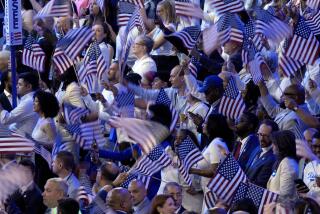In America, Old Glory represents more than just patriotism
- Share via
Poor Flag Day. It has to be the single most ignored national holiday in an otherwise patriotic country that loves its holidays — and no, it’s not just because we don’t get the day off. Nor is it because Flag Day gets lost between Memorial Day and the Fourth of July. The real reason that most Americans ignore the June 14 holiday is that it’s utterly redundant. In the United States, every day is Flag Day.
That’s right. In this flag-crazy world, Americans are arguably the most obsessed with our national banner. I’m not just talking about the obvious wartime or post- 9/11 flag waving. I’m referring to the everyday ubiquity of the Stars and Stripes. Have you been watching the NBA Championship Series? Did you notice that there’s an image of the flag on the bottom right-hand corner of the glass backboard? Or how about the phalanx of flags you often encounter at random gas stations? What’s with that?
Unlike other nations — India, for example — that discourage the rampant reproduction of their national banner, in the U.S. you can find the Stars and Stripes on everything from T-shirts to jeans, sports jerseys to mattress advertisements. British social psychologist Michael Billig calls this “banal” — as opposed to “hot” — nationalism. The ubiquitous, barely noticeable flag imagery, “which is so forgettable,” he writes, “ is at least as important as the memorable moments of flag waving.”
“Mindless flags,” as Billig calls them, are constant, largely unconscious “reminders of nationhood.”
Not surprisingly, foreign observers have written most penetratingly about America’s obsession with its flag. The late French cultural theorist Jean Baudrillard suggested that the omnipresence of the U.S. flag bears witness to a society that is “endlessly concerned with vindicating itself, perpetually seeking to justify its own existence.” As obnoxiously snarky and Euro as that sounds, there’s a lot of truth to it.
The unusually abstract nature of our civic patrimony — life, liberty and the pursuit of happiness — coupled with the highly mobile character of our society has long made us hungrier than other nations for the constancy and comfort of national symbols. Historically, patriotism sprang directly from an ancestral love of place, the hills and valleys where you were rooted, from which you derived sustenance and family lore. But here in the U.S., “our ancient roots into the earth of America had … an anchorage less firm,” as one historian put it. Both the continental breadth of our territory and the global reach of our power and culture make the warm embrace of the local less likely. So we seek meaning in tangible symbols, like the flag, say, or documents like the Constitution or the Declaration of Independence, which are revered as objects as well as for what they say.
The inherent fractiousness that comes with a wildly heterogeneous society has also made Americans crave symbols of unity. While the cult of the Stars and Stripes is as old as the republic, it acquired a new intensity during the Civil War. According to Italian historian Arnaldo Testi, author of the recently published “Capture the Flag: The Stars and Stripes in American History,” it was during the war that “the national flag established itself as a central pervasive icon of Northern public life” and earned the nickname “Old Glory.”
But ultimately it was the massive immigration at the end of the 19th century that gave us the Pledge of Allegiance and the first celebrations of Flag Day, in the teeming immigrant cities of New York, Philadelphia and Chicago. Proponents of these rituals feared the centrifugal cultural pull of the newcomers and wanted to create common cause amid the cacophony. Mostly they were trying to win the hearts and minds of the children of immigrants.
Historically, flags have been primarily understood as outward signals of origin or loyalty. And that continues to explain at least some of our show-the-flag propensities. But in the end, our flag waving has less to do with our need to signal our presence to external friends and foes than it does to remind ourselves of the central unum in our wild and wooly pluribus. And for that, we still need a lot more than a single Flag Day a year.


